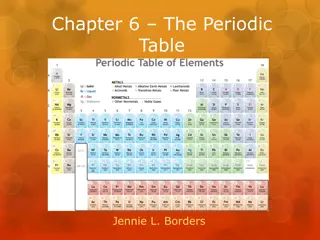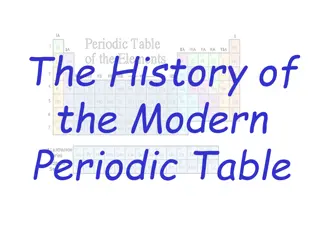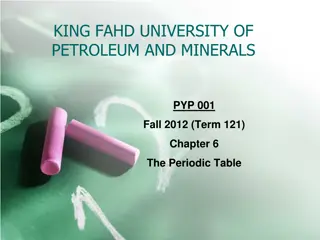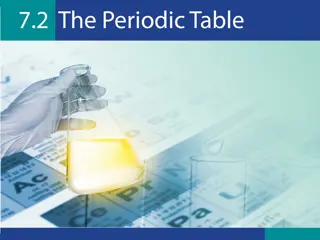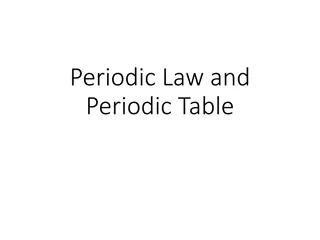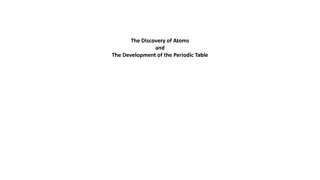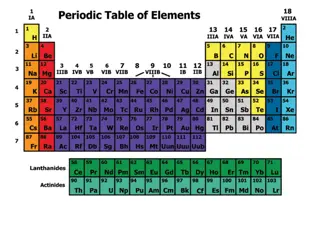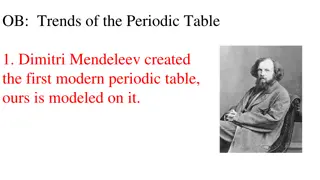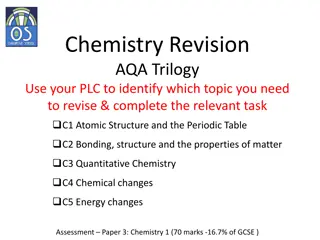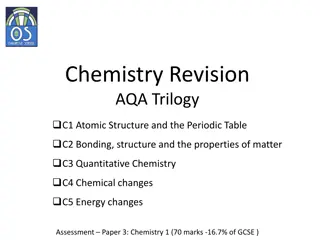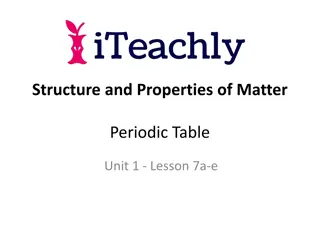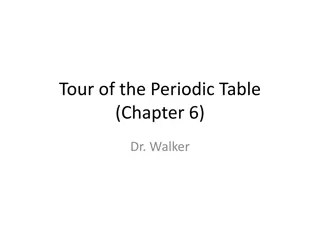Understanding Chemistry: Elements, Periodic Table, and Interactions
Delve into the world of chemistry, exploring the fundamental concepts of elements, the development of the periodic table by scientists like Mendeleev and Moseley, and how elements interact with each other. Discover the properties of elements, atomic structures, and the organization of the periodic table to deepen your knowledge of the building blocks of matter.
Download Presentation

Please find below an Image/Link to download the presentation.
The content on the website is provided AS IS for your information and personal use only. It may not be sold, licensed, or shared on other websites without obtaining consent from the author. Download presentation by click this link. If you encounter any issues during the download, it is possible that the publisher has removed the file from their server.
E N D
Presentation Transcript
Chemistry of Matter Properties and Interactions of Elements MS State Objectives 2.a. and 2.b.
Elements Elements are substances that cannot be broken down into simpler substances. Made up of only one type of atom Basic building blocks of matter The smallest particle of an element is an atom.
Review How many protons does this element have? How many electrons does this element have? What is the atomic mass? How many neutrons does this atom have? What is the atomic number? Can you tell which element this is using any of this information? Explain.
Developing the Periodic table Dmitri Mendeleev, a Russian scientist discovered a set of patterns that seemed to apply to all elements arranged the elements in order of increasing atomic mass (protons + neutrons in the nucleus)
Modern Periodic Table In 1913, Henry Moseley discovered a way to measure the positive charge in the nucleus to determine the atomic number arranged the elements by increasing atomic number instead of atomic mass
Periodic Table Arranged by increasing atomic number (proton #) Rows are called periods & are labeled 1-7 There are 18 columns Each column contains a group or family of elements. Groups are elements that have similar physical or chemical properties. Ex. All elements in group 1 are metals & react violently with water.
Groups/Families Groups 1 and 2 along with Groups 13 and 18 are called the representative elements. -elements having similar properties.
Groups/Families Groups 3 to 12 are called the transition metals.
How Elements Interact State Objective 2.a.
Physical vs. Chemical Change Physical change occurs when the physical properties are changed, such as size or shape. Ex. Folding a piece of paper or a change in the state of matter: solid, liquid, gas Chemical change occurs when the chemical properties of the substance cause a change producing a new substance (the atoms have rearranged)
Examples of Chemical Reactions Food spoiling Combustion (fast Oxidation) Rusting (slow oxidation) Photosynthesis Respiration Tarnishing Food Cooking http://dadomatic.com/wp-content/uploads/2009/01/brown-apple.jpg
Interaction Between Elements: If there are 110+ elements, how is it possible to have millions of different substances? Compounds are substances that form when two or more elements combine from a chemical change. Ex. NaCl (Sodium Chloride) The properties of compounds are different from the properties of the elements that make up the compound A molecule is the smallest particle of a substance with the same properties of that substance. Ex. H2O (water) Each molecule behaves like water, if the molecule is divided, Hydrogen and oxygen no longer behave like water
How do Elements Interact in Chemical Changes? Chemical properties of elements are determined by the number of electrons in the outer most energy level called valence electrons Valence electron number is determined by the group number for representative elements
Element Families have similar chemical properties Alkali Metals: Group 1; 1 valence electron Alkaline Earth Metals: Group 2; 2 valence electrons Halogens: Group 17; 7 valence electrons Noble Gases: Group 18; 8 valence electrons
Practice Use the periodic table to answer the questions. How many valence electrons does sodium have? How many electrons are found in the electron cloud of an atom of chlorine? What is the group number for each of the atomic models below? 1. 2. 3.
Chemical Bonds Elements bond to other elements to become stable by having a full valence shell. Most elements need 8 valence electrons to become stable Elements will become stable by losing, gaining, or sharing valence electrons Elements that lose electrons become positively charged ions. Elements that gain electrons become negatively charged ions. Types of bonding: Ionic Covalent
Ionic Bonding Ionic bonding is when a strong attraction occurs between oppositely charged ions to hold them close together to become stable (like two magnets) Ion: an atom that no longer has a neutral charge because it has lost or gained an electron Typically between a metal & non-metal Ex. Na+Cl-
Covalent Bonding Covalent bonds are chemical bonds that form from atoms that share valence electrons to become stable Occurs between two or more nonmetals Ex. H2, Cl2 , H2O , C6H12O6
Chemical Formulas Chemical formulas show a combination of chemical symbols & numbers that indicate which elements & how many atoms of each element are present in a compound. H2O (Water) C6H12O6 (Sugar/glucose) O2 (Oxygen Molecule) CO2 (Carbon Dioxide) N2(Nitrogen Molecule) Subscript: # of atoms
Chemical Equations A process that produces a chemical change is called a chemical reaction. Reactants are substances that exist before the reaction begins Products are substances that form as a result of the reaction Chemical equations tell chemists the reactants, products, and proportions of each substance present in a reaction ( like a recipe) Ex. 2H2 + O2 2H2O Reactant Product
Law of Conservation of Mass The Law of Conservation of Mass states that mass (matter) can neither be created nor destroyed. Therefore, atoms are never lost or created during a chemical reaction. Chemical equations must be balanced in order to show the same number of atoms for each element on the reactant & product side of the equation.
Balancing an Equation Ex. 2H2 + O2 Reactant 2H2O Product
Chemistry of Matter Forming Acids & Bases State Correlation 2b
Properties of Acids & Bases An acid is a compound that produces hydrogen ions in water (H+) The greater the concentration of H ions produced, the stronger the acid Tastes sour Reacts with non-metals Have a pH < 7 Turn blue litmus paper red Examples: HCl, H2SO4, HNO3
Properties of Acids & Bases A base is any compound that produces hydroxide ions (OH-) in water. The greater the concentration of OH-produced, the stronger the base. Taste bitter & feels slippery Reacts with metals Have a pH > 7 Turn red litmus paper blue Examples: NH3, NaOH, NaHCO3
Predicting Acids & Bases using the Periodic Table Acids form when hydrogen chemically combines with certain nonmetals. All halogens (group 17) form acids when combined with hydrogen Ex. Fluorine & hydrogen (HF)
Predicting Acids & Bases using the Periodic Table Bases form when a hydroxide ion (OH-) joins with a metal The metals in group 1 (alkali metals) and group 2 (alkaline earth metals) readily form bases with hydroxide ions EX. KOH EX. Ca(OH)2




